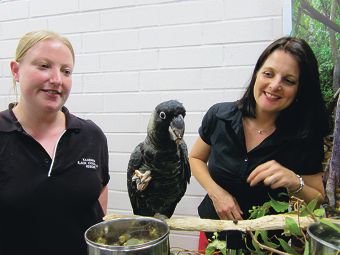Parrot loses feathers on beer and chips diet
 Thursday, February 23, 2012 at 12:32
Thursday, February 23, 2012 at 12:32  Psittacus erithacus - African Grey Parrot | in
Psittacus erithacus - African Grey Parrot | in  Pet care,
Pet care,  Rescue
Rescue
 Thursday, February 23, 2012 at 12:32
Thursday, February 23, 2012 at 12:32  Wednesday, February 22, 2012 at 14:25
Wednesday, February 22, 2012 at 14:25  Kaarakin wildlife and clinic manager Louise Hopper introduces the Member for East Metropolitan Region Alison Xamon to Jason the cockatoo. MEMBER for East Metropolitan Region Alison Xamon says protecting the remaining forest areas in the State will help protect rare and endangered cockatoos.
Kaarakin wildlife and clinic manager Louise Hopper introduces the Member for East Metropolitan Region Alison Xamon to Jason the cockatoo. MEMBER for East Metropolitan Region Alison Xamon says protecting the remaining forest areas in the State will help protect rare and endangered cockatoos.
The comments came after Ms Xamon attended a Conservation Council of WA meeting earlier this month, which heard from experts on the topic Why WA’s rare and endangered cockatoos are starving.
“It is quite clear that our native cockatoos, in particular the Carnabys, Baudins and Forest Red Tailed Black Cockatoos are under threat and this has been attributed to a combination of land clearing, drought and fire,” she said.
 Wednesday, February 22, 2012 at 12:15
Wednesday, February 22, 2012 at 12:15  Camouflaged: The Kakapo parrot, one of just 124, was captured amid dense scrub on a compact cameraThink pandas are inept when it comes to carrying on the species? Think again. The giant panda is a champion reproducer compared to a chubby, land-bound parrot called the kakapo. Between navigational problems, botanical problems, and the occasions when horny male parrots try to have sex with animals that can kill them, this is the most hopelessly inefficient reproducer on Earth.
Camouflaged: The Kakapo parrot, one of just 124, was captured amid dense scrub on a compact cameraThink pandas are inept when it comes to carrying on the species? Think again. The giant panda is a champion reproducer compared to a chubby, land-bound parrot called the kakapo. Between navigational problems, botanical problems, and the occasions when horny male parrots try to have sex with animals that can kill them, this is the most hopelessly inefficient reproducer on Earth.
 Strigops habroptilus - Kakapo | in
Strigops habroptilus - Kakapo | in  Conservation,
Conservation,  Fun,
Fun,  Oddities
Oddities  Monday, February 20, 2012 at 23:04
Monday, February 20, 2012 at 23:04
Maybe he thought they were worms.
This bird made an unlikely four-legged friend after feeding a dog noodles from the kitchen counter top.
 Cacatua goffiniana - Tanimbar Corella | in
Cacatua goffiniana - Tanimbar Corella | in  Fun,
Fun,  Oddities
Oddities  Monday, February 20, 2012 at 12:32
Monday, February 20, 2012 at 12:32  Birds Carrier passing by, on the narrow streets of Benares. Image by Aegon Targaryen Rosy ringed Parakeets are most common illegally traded birds in India. Every other week scores of beautiful Indian parakeets are rescued by People For Animals volunteers and brought to Sanjay Gandhi Animal Care Centre. They are taken off trains and tops of buses, hundreds cramped into square cane boxes with split levels. The bottom layer is barely 6 inches tall and the birds are squatting, many of them with broken legs and wings covered with the faeces of the top layer birds. The boxes are covered by gunny bags and many die from suffocation.
Birds Carrier passing by, on the narrow streets of Benares. Image by Aegon Targaryen Rosy ringed Parakeets are most common illegally traded birds in India. Every other week scores of beautiful Indian parakeets are rescued by People For Animals volunteers and brought to Sanjay Gandhi Animal Care Centre. They are taken off trains and tops of buses, hundreds cramped into square cane boxes with split levels. The bottom layer is barely 6 inches tall and the birds are squatting, many of them with broken legs and wings covered with the faeces of the top layer birds. The boxes are covered by gunny bags and many die from suffocation.